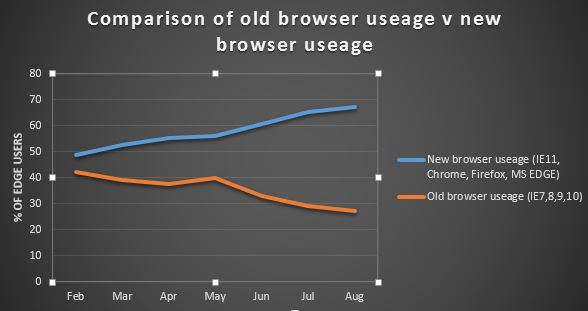The past month has followed the standard school holidays trend, whereby the volume of calls received by the EDGE team drops which allows us to turn our attentions to the plethora of other tasks that we are working away on in the background.
One of our objectives over the past year has been to try and encourage our users to upgrade their browsers in order to see improved performance speeds on EDGE, especially when running large reports that return a lot of data. Just a few of the benefits of browser upgrades can be found on the NHS Supply Chain website:
‘Why should you update your browser?
Old browsers are more prone to viruses, spyware, malware and other security issues. Whilst you will be protected by your trust’s firewalls there are other reasons why you should upgrade your Internet browser…
- Old browsers are slow - In comparison to newer browsers, old browsers such as IE 6, 7 and 8 can take longer to display the web page you want to view as browsers are trying to perform several complicated tasks at once.
- Old browsers are more likely to crash - When a web page downloads, your browser is performing several tasks and interpreting new programming information that was not available when the browser was originally launched.
- You can’t view websites properly with old browsers - As web design and development becomes more sophisticated, you may not be able to view some websites as intended e.g. images may not be displayed, video may not play and content displayed may appear misaligned’
Supporting EDGE across multiple browsers also increases the time it takes for us to develop and test current and new functionality. The more redundant software we have to support, the more development time each feature requires, this in turn has an additional effect on testing each function within each browser. The overall effect being that new functionality is held up by the use of older browsers.
Microsoft’s dominance in the web browsing market really started with Internet explorers inclusion in Windows 95, where it surpassed Netscape Navigator as the most used browser on the web back in 1998. Microsoft has held that position of dominance for almost two decades until April this year when statistics firm Netmarketshare said that Google Chrome had overtaken it with 41.7 per cent of desktop browsing, compared with Internet explorers 41.3 per cent.
A statement released from Microsoft at the end of last year notified Internet explorer users that ‘Starting from 12 January 2016, only the most current version of Internet Explorer available for a supported operating system will receive technical supports and security updates. Internet Explorer 11 is the last version of Internet Explorer, and will continue to receive security updates, compatibility fixes and technical support on Windows 7, Windows 8.1 and Windows 10’
This ties in with the recently released Review of Data Security, Consent and Opt-Outs, published by Dame Fiona Caldicott https://www.gov.uk/government/publications/review-of-data-security-consent-and-opt-outs within which she highlights under the ‘Leadership Obligation 3: Technology: Ensure Technology is secure and up-to-date’, ‘Data Security Standard 8. No unsupported operating systems, software internet browsers are used within the IT estate’
This guidance is correct, browsers should be updated for security purposes. This is put in no uncertain terms by Ed Bott, an award winning technology writer:
“Any IT professional who is still allowing IE6 to be used in a corporate setting is guilty of malpractice. Think that judgment is too harsh? Ask the security experts at Google, Adobe, and dozens of other large corporations that are cleaning up the mess from a wave of targeted attacks that allowed source code and confidential data to fall into the hands of well-organized intruders. The entry point? According to Microsoft, it’s IE6”
Is this easier said than done though? Well it used to be the case that a number of core applications i.e Spine, and e-RS (formerly choose & book) used to be limited to access from IE 6 and IE 7 browsers, but recently that has changed and the Health & Social Care Information Centre (now NHS Digital) released their new Spine Warranted Environment Specification in 2015 which introduced components for MS Internet Explorer 11, Mozilla Firefox and Google Chrome. Therefore compatibility with current technology is improving but there are no doubt other applications still reliant on older technology.
We have been reviewing EDGE users browser access over the past six months and have seen a significant trend in users upgrading their existing legacy browser to more current versions of the software. These can be seen on the graph below. The only exception is IE7, which has increased from 3.1% of EDGE users to 5%. We believe this increase is probably down to new users introduced onto the system rather than users actually downgrading their browser.
·
These statistics are positive, identifying a downward trend in use of IE8 and IE9, very little change in IE10 use, but a good increase in use of newer browsers such as IE11, Chrome and Firefox.
The below graph consolidates these statistics into simply ‘old browsers v new browsers’
After initial analysis of browser usage in September 2015, we implemented a formal browser policy for development and test in order to support our customers’ needs and maintain EDGE as a safe and reliable system, and is highlighted in the following points:
· The new browser policy ceases any support for IE6 due to the lack of users
· IE7 is now only offered reduced support*
· IE8, 9, 10, 11 are fully supported however we are aiming to reduce support for IE8 by (date TBC)
· Google Chrome, Mozilla Firefox, and MS Edge are fully supported.
*reduced support means that functionality will be supported, but any cosmetic issues will not be fixed.



